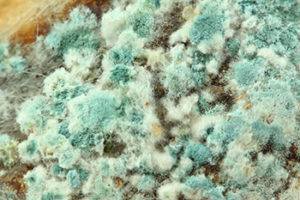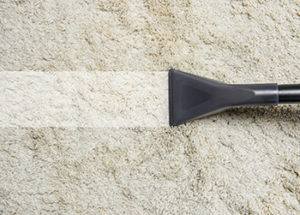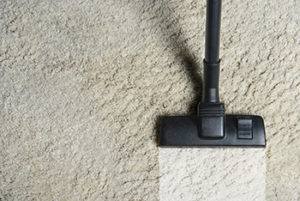How To Clean Mold Out Of Carpet
Carpets can provide you with a tough and terrible house guest: mold! And while you may not have planned on spending your weekend getting mold out of your carpet, it may be the best use of your time. Your health and the health of your family and pets could severely suffer if you are living in a home with moldy carpets.
Hiring in a professional cleaning company may be your only option when you are dealing with a large area of contamination, but smaller spots are well within your power to remedy.
- What Is Mold?
- Why Is Mold Bad For Your Health?
- How To Clean Mold From Carpet
- The Mold Cleaning Process: 4 Easy Steps
- Professional Cleaning: What Is It All About?
- What About Black Mold?
- FAQs
- Conclusion
What Is Mold?
Mold is the loosely-used common term for fungal growth. Whenever your carpet is exposed to damp, persistent leaks or liquid spills such as animal urine, you run the risk of fungal growth. Sadly, mold is one pernicious and industrious organism—it can grow in a matter of days!

The musty or stale odor of mold can help you track down where it has decided to grow, but the odor can also be challenging to remove, even after you have treated the area. Hence, mold growth should be tackled as soon as possible; otherwise it can spread dramatically within a short time.
To prevent mold from growing in your carpets, you should:
- Ensure your carpets, underlay, and substrata support of older floors (like wood floors) are kept damp free
- Try to bring sunlight into your home: mold is easily controlled by UV light, so open those curtains and blinds
- Watery spills should be eliminated immediately
- Wood floors should be cleaned and sanded per the manufacturer's recommendations, especially when they are covered with carpet
- Carpets should be vacuumed regularly to prevent a buildup of microparticles, which can increase moisture retention, leading to damp fibers
Back To Top
Why Is Mold Bad For Your Health?
If you or your family are suffering from runny noses, allergies, sore throats, and headaches when you are at home, there may be a chance that there is an underlying mold problem. Should you not treat this problem effectively, your health can suffer over the long term.
Those with chronic lung problems are more susceptible to the spores that mold produces, and this can cause massive health issues such as asthma. Mold can be classified in three groupings: allergenic, pathogenic, and toxigenic.
Cladosporium is the most common type of mold found in American homes, and it thrives on damp carpets, upholstery, and behind wallpapers. It has a suede-like texture and is olive-green or brown. It is found in both warm and cooler climates, so northern states are also susceptible to this kind of mold.
This mold is classified as allergenic and causes sinusitis, rashes, and lesions of the lungs if inhaled.
When cleaning your home, it is advisable to wear masks and surgical gloves to prevent accidental exposure to the spores and smaller cells, which may break off upon contact. They can easily become lodged in the skin where they cause irritation.
Removing mold from your home and from your carpets is thus a vital goal for healthy living. Before you rip up all your carpets and opt for a more water-resistant surface, like tiles, you should consider taking steps to remove mold from carpets. Ridding your carpets of mold is not as difficult as you may think, so keep reading to learn how to undertake this process.
Back To Top
How To Clean Mold From Carpet
Getting mold out of carpet involves first assessing whether it's a few moldy spots or a massive growth that may require expert cleaning. Start by drying the affected areas, scrubbing with a cleaning solution, and then vacuuming to remove any residual mold traces.

It is important to ensure you prevent mold from forming again by keeping that area dry and regularly vacuuming or steam cleaning. This removes mold particles and the dust that creates the "bed" in which the mold takes root.
Remember that mold is not an unnatural thing, and you can easily track the spores into your home from outside with your shoes, bags, and other objects that enter and exit.
Regular cleaning will help reduce these moldy elements and lower the potential for growth. After all, the only other missing ingredient is a wet or moist environment. Under wet conditions, mold will almost magically appear! So make an effort to keep your carpets clean and dry.
Back To Top
The Mold Cleaning Process: 4 Easy Steps
- 1. Isolate
- 2. Protection
- 3. Carpet Area
- 4. Natural vs Chemical Cleaners
Ok, so you somehow managed to miss a spot when vacuuming, or some perhaps damp conditions formed in your beloved carpet. Now, you are stuck with an unsightly and smelly olive-green fluff patch that looks like the suede cloth of a bell-bottom from Woodstock. What now?
Cleaning is easily done in 4 basic steps:
1. Isolate
It is important to keep the area closed off from the rest of your home. If it is in a bedroom, close the door while you prepare to treat the mold.
Keep people and pets away from the area, as you don't want them walking through the mold and tracking spores into the rest of your home, allowing the mold to spread further.
2. Protection
Before you start working, protect your face and hands with a mask and gloves. No matter how small the affected area may seem, that telltale cough you develop when working with moldy or dusty areas is a clear indication of mold spores and smaller particles in the air.
For larger areas of mold, you may have to enlist the help of a professional cleaning company that will be better equipped to deal with mold and vacuum up all mold particles. Professionals will ensure that while they clean, they don't spread the growth to other areas.
Personal protective equipment for large-scale mold treatment may include full protection gear with oxygen-supplied hermetically sealed suits, double-sealed gloves, and taping off the room where the mold is present.
Mold can be such a difficult organism to treat because it can easily take up lodgings in your furniture, upholstery, curtaining, wallpaper, wall ornaments, and even in your subflooring. If you end up with a larger mold problem, it is not cost-effective to try and combat it yourself, nor is it a good idea to compromise your health by trying.
3. Carpet Area
Determine the extent of the damage. If the mold has had some time to settle in, you may end up having to replace the core area where the damage is extensive. Should you need to, you might have to open the siding on your carpet and lift the underlay in order to have a real look at the full damage.
Sometimes, you will have to replace the underlay, cut out the worst sections of the carpet, and replace these with new carpet or new padding. This can be an awful experience: when you lift your carpet, only to realize the damage is beyond salvageable.
Hence, you must remove mold from carpet as soon as you spot it. Don't wait.
4. Natural vs Chemical Cleaners
Decide whether you will use natural or chemical products to clean the area. This choice is not so much based on effectiveness or price, as both options are effective and reasonably cost-efficient. It may be more a personal decision or one of convenience.

Natural cleaning options such as baking soda and vinegar require a little more elbow grease to apply effectively, while chemical spray products only require a light spray and vacuuming afterwards, making the latter option more convenient.
For natural cleaning:
The steps of cleaning up mold spots with natural cleaning products are as follows:
- Liberally layer the moldy area with baking soda, softly scrubbing it into the affected area with a stiff bristled brush.
- Leave overnight.
- Vacuum up the baking soda the next morning.
- Scrub with white vinegar.
- Thoroughly vacuum affected area.
Note: Using a vacuum cleaner with a HEPA filter will ensure you don't accidentally flush the mold spores into the air of your home, from where they can disperse and contaminate the rest of your carpet or even your lungs. You will have to replace the filter immediately after cleaning the affected area, as you don't want to accidentally spread the mold spores to the rest of your home upon your next vacuum.
For chemical cleaning:
Decide on which cleaning product you would like to use. A mold-busting chemical cleaning product, like Concrobium 25326 Mold Control Spray or Allersearch ADS Anti-Allergen Dust Spray, is specially designed for its ease of use. Both are safe to use on carpets, don't contain harmful chemicals that could affect children or pets, and are easy to apply.
The steps for cleaning with a chemical cleaning product are as follow:
- Simply apply or spray chemical treatment to the affected area.
- Allow to dry (sometimes overnight).
- Scrub with a hard-bristled brush.
- Vacuum with a HEPA-filtered machine.
- Be sure to replace the HEPA filter on your vacuum cleaner.
Alternatively, you could use a steam cleaner to flush out the last remaining particles. Thoroughly check whether the area is dry before allowing traffic through the room again.
Back To Top
Professional Cleaning: What Is It All About?
- Dry Out The Area
- Create Negative Air Pressure
- Fungicidal Treatment
- Cleanup And Repairs
When using a professional cleaning service to remove mold from carpets in your home, you can expect them to do the following:
Dry Out The Area
The pros will bring industrial drying equipment like commercial dehumidifiers. Once they have sealed the room where the mold was found, they will begin to dry out the carpet and surrounding areas.
Create Negative Air Pressure
The sealed room will be turned into a negative air pressure area, meaning that no molecules or spores of mold can accidentally flow out of the room. In essence, they will be working in a vacuum.
Fungicidal Treatment
Next, the professionals will begin to treat everything in the room with fungicidal solutions. Some of these may not be safe for all the carpeting and surfaces in your room.
While you can expect some damage if the mold colonies have grown extensively, you can salvage your possessions if you remove them from the room, clean them in your yard, and expose them to sunlight to kill off any remaining mold spores.
It is important that all porous surfaces be treated, as these can all harbor mold spores that could regrow.
Cleanup And Repairs
Once the area has been treated with fungicides, the area will be stripped of all damaged materials such as rotten carpets, corroded floorboards, invested drywalling, etc. Repairs can now be performed by replacing carpet sections, refurbishing floorboards and drywalls, and if necessary, replacing drapery and air filters in AC units.
Back To Top
What About Black Mold?
Stachybotrys or the dreaded black mold is a nefarious fungus that can quickly take over in moist and humid conditions. It is usually found in bathrooms or near heating units. Dark green or black in color, it has a slimy texture, which allows you to see the difference between it and cladosporium.
Black mold is a toxigenic type of mold, which means it has serious health implications for people. It thrives in cellulose material such as natural fiber carpets, and like all molds, it is one tough critter to get rid of.
Knowing how to get black mold out of carpet seems to be a trump card for most industry cleaning specialists, but is it really necessary to hire professional cleaners simply because of the dreaded black mold?
Simply put, NO. You can clean black mold in the same way as you clean other molds. All mold species can be cleaned in similar ways.
Even the Centers for Disease Control and Prevention (CDC) has indicated that black mold poses no greater threat than other mold forms. Still, care should be taken, and the decision whether or not to get a professional to remove mold from your home is more determined by the extent of the damage and not by the type of mold.
The golden rule is then to treat mold immediately, never giving the colonies time to multiply. Mold can quickly cause permanent damage to flooring, carpets, and drywall, so it is best to act quickly.
If left untreated, you could end up with a much larger repair bill should you require professional intervention, and the damage to your health may be irreparable.
Back To Top
FAQs
- How Do You Get Mold Out Of Carpets?
- Is Carpet Mold Dangerous?
- What Kills Mold And Mildew In Carpet?
- Will Shampooing Carpets Get Rid Of Mold?
Mold is a problem for homeowners worldwide, and we know you have questions. Here are a few typical questions and answers about mold and carpets, and you are welcome to leave us some questions in the reply section too.
How Do You Get Mold Out Of Carpets?
When you want to remove mold from your carpets, you should start by ventilating the area so the mold spores can rise from the carpet weave, then by scrubbing the area with a hard brush to loosen any spore buildup. Then apply a mold-cleaning product. Lastly, thorough vacuuming with a HEPA-filtered vacuum cleaner will remove any remaining spores from the carpet pile.
Is Carpet Mold Dangerous?
While most forms of mold are not lethal to people, they can cause serious allergic reactions. People with asthma are most susceptible.
If you have children or animals in the house, they can become exposed to the toxic mycotoxins from mold. These can cause more serious health complications.
Mold spores can also become aerosolized (lodged in the lungs), which can cause breathing problems, increasing the risk of developing asthma.
What Kills Mold And Mildew In Carpet?
As a natural alternative, you can clean your carpet and kill off fungus like mold with baking soda and vinegar. Simply sprinkle a good amount of baking soda over the area, scrub, and leave overnight. Then vacuum, scrub with vinegar, and vacuum the area again.
Will Shampooing Carpets Get Rid Of Mold?
Shampooing your moldy carpet may wash away the visible signs of mold, but it will not rid your carpet of the invisible spores that lodge in carpet fibers.
To remove mold from your carpet, you need to either dislodge the spores with a coarse substance like baking soda, or shrink them with chemicals that will kill them. Shampoo will not remove the spores but may lighten the color or odor of the mold temporarily.
Back To Top
Conclusion
Finding mold on your carpet can be a nightmare. But if you act swiftly, you can quickly rid yourself of this nasty, smelly, and potentially dangerous hazard. With the bare minimum of equipment such as baking soda and vinegar (or a suitable carpet spray), a brush, a HEPA-filtered vacuum, and some gloves and a mask, you can rid yourself of mold overnight.
Don't ignore darker spots or musky smells. Take the necessary precautions to ensure your home is safe for you and your family by dealing with carpet mold right away.
If you have any comments or first-hand experiences with removing mold from your carpet, please post them below or share your pictures via our social media.
Back to Top
How To Clean Mold Out Of Carpet
Source: https://floorcritics.com/how-to-get-mold-out-of-carpet/
Posted by: dawdide1988.blogspot.com

0 Response to "How To Clean Mold Out Of Carpet"
Post a Comment